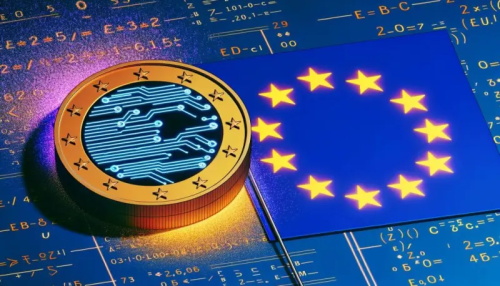EU’s Digital Euro Test: Privacy Concerns vs. CBDC Necessity

As the global wave of digitalization continues to surge, Central Bank Digital Currencies (CBDCs) have become a central focus for major central banks worldwide. The European Union is actively accelerating its efforts to develop the digital euro as part of its broader push toward financial digitalization. With the digital euro now entering the testing phase, technological exploration is transitioning into tangible development. This marks a pivotal moment in the evolution of fintech within the eurozone and has sparked widespread attention regarding privacy protection, financial sovereignty, and the stability of cross-border payments.
From Concept to Pilot: The Digital Euro Gains Momentum
The European Central Bank (ECB) recently announced the launch of the Digital Euro Innovation Hub, bringing together companies from the fintech, telecommunications, and professional services sectors to test payment functionalities and real-world application scenarios through October this year. In fact, the EU has been pushing the digital euro for several years. In 2020, the ECB released its first Digital Euro Report, explicitly stating that the digital euro would serve as a complement to cash and bank deposits. By 2021, the project entered the research and framework-building stage, and in October 2023, it formally entered the preparation phase. According to the current timeline, the ECB will decide this October whether to proceed to the next phase and formally initiate the issuance of the digital euro.
Several strategic factors are driving this initiative. On one hand, the usage rate of electronic payments in the eurozone continues to rise, while cash transactions decline. The EU urgently needs to take control in the realm of digital payments. On the other hand, major global economies—such as China and the U.S.—have made significant moves in the CBDC space. With Europe relatively lagging in payment infrastructure, enhancing digital sovereignty and financial autonomy has become a policy priority.
The Shadow of Privacy: Digital Euro’s “Grey Zone”
Although the digital euro is regarded as a crucial step in modernizing payment systems, it has also raised increasing concerns over privacy and data protection—especially in sensitive scenarios like cross-border payments, where the use, transfer, and safeguarding of user data have become core issues.
First, the principle of “data minimization” is under pressure. In theory, any technological system should collect only the minimum amount of user data necessary. However, given the diversity of functions and application scenarios envisioned for the digital euro, the risk of excessive data collection looms large.
Second, vague definitions surrounding data further complicate regulatory efforts. The current Digital Euro Proposal does not clearly define critical terms such as “transaction data” or “user identifiers.” This lack of clarity creates legal ambiguities and regulatory loopholes—particularly problematic for cross-border transactions that may involve multiple national regulatory standards.
A more complex challenge is balancing “privacy protection” with the “public interest.” Completely anonymous transactions may safeguard personal privacy but could also facilitate money laundering and illicit financing. Conversely, requiring identity verification could expose sensitive information—such as geolocation and transaction history—to intermediaries, raising the risk of misuse or data breaches. This tension between anonymity and traceability is a core dilemma in designing the digital euro system.
Programmable Money: The Subtext of Control
Unlike traditional currency, CBDCs are programmable, meaning they’re not just payment tools but also “controlled currencies.” The digital euro, fundamentally built on blockchain and governed by smart contracts, allows central banks to control issuance and circulation—and potentially impose limits on how much an individual can hold.
The ECB has already indicated that to preserve financial system stability, it may cap the amount of digital euros individuals can hold in their accounts. Officially, this is to prevent the digital euro from evolving into a store of value, which could destabilize commercial bank deposit bases. However, many view this as a form of “invisible financial surveillance.” If all transactions are conducted online and are traceable, cash may gradually disappear from circulation—leaving a data trail of every purchase and transfer.
Global Geopolitics Behind Digitalization
Europe’s move toward digital currency must also be understood in the global context. According to the Official Monetary and Financial Institutions Forum (OMFIF), around 41% of the world’s central banks are expected to issue CBDCs within five years, and this figure could reach 70% within a decade. CBDCs are becoming a critical tool in the next phase of global financial competition and cooperation.
However, this trend introduces significant systemic risks. While CBDCs offer high efficiency in cross-border use cases, they also pose “currency substitution” risks that could undermine the status of national currencies. Additionally, increased volatility in capital flows and accelerated transmission of financial risk across borders may threaten the stability of the current international monetary system. In the absence of a unified regulatory framework, compatibility and legal alignment among different national CBDCs remain urgent challenges.
The emergence of the digital euro is both a natural outcome of financial system digitalization and a critical step for the EU to achieve technological independence and monetary sovereignty. Yet this digital transformation comes with substantial privacy risks, potential for financial control, and the need for international coordination. From technical architecture to legal frameworks, from data protection to financial ethics, the EU must face the complex battles and uncertainties ahead as it attempts to shape the financial order of the future.
The future of digital currency is still in flux, but the trajectory of the digital euro will undoubtedly become one of the key indicators of global CBDC development.



